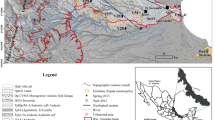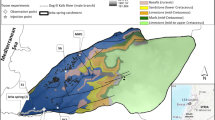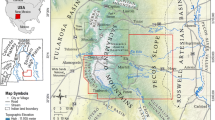Abstract
Groundwater in mountainous karst regions is vital for regional water budgets and freshwater supply. Owing to increasing water demand and climate change, detailed knowledge of the highly heterogeneous alpine aquifer systems is required. Multi-tracer analyses have been conducted in the steep karstic Wetterstein Mountains, which includes Germany’s highest summit, Zugspitze (2,962 m asl). Results of artificial tracer tests demonstrate well-developed flow paths through the unsaturated zone (up to 1,000 m thickness). Flow paths cross topographic divides and contribute to deep drainage systems underneath alpine valleys. Cross-formational flow has been identified. Quantitative analysis of tailing-dominated breakthrough curves and stable isotopes (18O) has enabled determination of the mean transit-time distribution. A fast-flow component with transit times between 3 and 13 days was found in karst conduits and open fissures, dependent on flow conditions. An intermediate-flow component, showing mean transit times of about 2.9–4.9 months, was found in well-drained fissures and fractures. A slow-flow component with mean transit times greater than 1 year is attributable to slow flow and low storage in the poorly drained fissures and rock matrix. The conceptual model enables a better understanding of drainage, water resources and vulnerability of the high-alpine karst system.
Résumé
Les eaux souterraines dans des régions montagneuses karstiques sont essentielles dans les bilans hydrologiques régionaux et pour l’approvisionnement en eau douce. En raison de la demande en eau croissante et du changement climatique, la connaissance détaillée des systèmes aquifères alpins, fortement hétérogènes, est indispensable. Des multi-traçages ont été réalisés dans les montagnes karstiques à pentes raides du Wetterstein, qui inclut le plus haut sommet de l’Allemagne, Zugspitze (2,962 m). Les résultats des traçages artificiels mettent en évidence des cheminements bien développés de l’eau souterraine dans la zone non saturée (jusqu’à 1,000 m d’épaisseur). Les cheminements de l’eau traversent des lignes de partages topographiques et contribuent à un drainage profond en dessous des vallées alpines. Des écoulements recoupant plusieurs formations ont été identifiés. Des analyses quantitatives des courbes de restitution dominées par des effets de trainées et des isotopes stables (18O) ont permis la détermination de la distribution du temps de transit moyen. Une composante d’écoulement rapide, avec des temps de transit entre 3 et 13 jours selon les conditions de flux a été rencontrée dans les conduits karstiques et les fissures ouvertes. Une composante d’écoulement intermédiaire, avec un temps moyen de transit de l’ordre de 2.9–4.9 mois, a été identifiée dans les fractures et fissures bien drainées. Une composante d’écoulement lent, avec des temps de transit supérieurs à un an, est attribuable à un écoulement lent et un faible emmagasinement dans les fissures faiblement drainées et la matrice rocheuse. Le modèle conceptuel améliore la compréhension du drainage, des ressources en eau et de la vulnérabilité des systèmes karstiques alpins d’altitude.
Abstrakt
Grundwasser in alpinen Karstgebieten ist für den regionalen Wasserhaushalt und die Wasserversorgung wichtig. Aufgrund des zunehmenden Wasserbedarfs und der Klimaveränderungen ist eine umfassende Kenntnis der stark heterogenen alpinen Grundwassersysteme erforderlich. Untersuchungen mit mehreren Tracern wurden im steilen und verkarsteten Wettersteingebirge mit dem höchsten Berg Deutschlands, der Zugspitze (2,962 m), durchgeführt. Die Ergebnisse mit künstlichen Tracern zeigen, dass gut entwickelte Fließwege durch die ungesättigte Zone vorliegen (bis zu 1,000 m Mächtigkeit). Fließwege queren topographische Wasserscheiden und tragen zu tiefen Entwässerungssystemen unter hochalpinen Tälern hindurch bei. Eine Entwässerung durch stratigraphische Einheiten wurde nachgewiesen. Die quantitative Auswertung der tailing-dominierten Durchgangskurven und der stabilen Isotope (18O) ermöglichte die Bestimmung mittlerer Verweilzeiten. Eine schnelle Fließkomponente mit Verweilzeiten von 3 bis 13 Tagen wurde in Karströhren und offenen Klüften nachgewiesen; diese ist stark von den hydrologischen Abflussverhältnissen abhängig. Eine intermediäre Fließkomponente mit Verweilzeiten von 2.9 bis 4.9 Monaten wurde in hydraulisch gut vernetzen Klüften und Spalten vorgefunden. Eine langsame Fließkomponente mit Verweilzeiten von mehr als einem Jahr kann auf langsame Grundwasserströmung und Speicherung in schlecht vernetzten Klüften und Gesteinsmatrix zurückgeführt werden. Das konzeptionelle Modell ermöglicht ein besseres Verständnis der Entwässerung, der Wasserresourcen und der Verletzlichkeit des hochalpinen Karstsystems.
Resumen
El agua subterránea en regiones montañosas kársticas es vital para los balances regionales de agua y para el abastecimiento de agua dulce. Debido a la creciente demanda de agua y al cambio climático se requiere un conocimiento detallado de los sistemas acuíferos alpinos altamente heterogéneos. Se han realizado análisis de multitrazadores en las empinadas montañas kársticas de Wetterstein, lo cual incluye a la cumbre más alta de Alemania, Zugspitze (2,962 m snm). Los resultados de los ensayos de trazadores artificiales demuestran trayectorias de flujo bien desarrolladas a través de la zona no saturada (hasta 1,000 m de espesor). Las trayectorias de flujo atraviesan las divisorias topográficas y contribuyen al sistemas de drenaje profundo que subyace a los valles alpinos. Se identificaron los flujos a través de las formaciones. Los análisis cuantitativos de curvas de ruptura dominados por su parte posterior y de isotopos estables (18O) han permitido la determinación de la distribución del tiempo de tránsito medio. Se encontró una componente de flujo rápido con tiempos de tránsito entre 3 y 13 días en los conductos kársticos y fisuras abiertas, dependiendo de las condiciones de flujo. Se encontró una componente de flujo intermedio, con un tiempo de tránsito medio entre 2.9 y 4.9 meses, en las fisuras y fracturas bien drenadas. Una componente de flujo lento con tiempos de tránsito medio mayor que un año es atribuible al flujo lento y al almacenamiento bajo en las fisuras pobremente drenadas y en la matriz de la roca. El modelo conceptual permite un mejor entendimiento del drenaje, los recursos de agua y la vulnerabilidad del sistema kárstico alto alpino.
摘要
高山岩溶地区的地下水对区域水平衡和淡水供水至关重要。由于用水需求增加及气候变化,需要详细了解高度多样化的阿尔卑斯山含水层系统。在陡峭的岩溶韦特施泰因山脉,包括德国最高山Zugspitze峰 (2,962米),进行了多示踪剂分析。水流通道穿过地形分水岭,有助于阿尔卑斯山山谷之下的深部排水系统。确定了横跨地层的水流。拖尾主导的突破曲线和稳定同位素 (18O) 定量分析能够确定平均渡越时间分布。在岩溶通道和开放缝隙中发现存在着渡越时间为3到13天的快速水流成分,时间长短取决于水流条件。在水系发育的裂隙和断裂中发现中速水流成分,平均渡越时间为2.9到4.9个月。平均渡越时间大于一年的慢速水流成分是由排水不畅的裂隙和岩石基体内缓慢的水流和低存储量造成的。概念模型能够使人们更好地了解阿尔卑斯山岩溶系统的排水、水资源和脆弱性等情况。
Resumo
A água subterrânea em regiões cársicas montanhosas é vital para os balanços hídricos regionais e o abastecimento de água doce. Devido ao aumento da procura de água e às mudanças climáticas, é necessário o conhecimento detalhado dos sistemas aquíferos alpinos altamente heterogéneos. Foram realizadas análises multitraçador nas escarpadas Montanhas Wetterstein cársicas, que incluem o pico mais alto da Alemanha, o Zugspitze (2,962 m de altitude). Os resultados dos ensaios de traçadores artificiais demonstram caminhos de fluxo bem desenvolvidos através da zona não saturada (até 1,000 m de espessura). Os caminhos de fluxo cruzam divisórias topográficas e contribuem para sistemas de drenagem de profundidade por baixo de vales alpinos. Foi identificado fluxo interformacional. A análise quantitativa de curvas de chegada com diferimento dominante e isótopos estáveis (18O) permitiu determinar a distribuição do tempo médio de trânsito. Foi encontrado um componente de fluxo rápido com tempos de trânsito entre 3 e 13 dias em condutas cársicas e fissuras abertas, dependente das condições de fluxo. Um componente intermédio de fluxo foi encontrado em fissuras e fraturas bem drenadas, mostrando tempos médios de trânsito de cerca de 2.9–4.9 meses. Um componente de fluxo lento, com tempos médios de trânsito superiores a um ano, é atribuível a fluxo lento e ao escasso armazenamento nas fissuras mal drenadas e na matriz rochosa. O modelo concetual permite uma melhor compreensão da drenagem, dos recursos hídricos e da vulnerabilidade do sistema cárstico alpino de grande altitude.













Similar content being viewed by others
References
Bakalowicz M (2005) Karst groundwater: a challenge for new resources. Hydrogeol J 13(1):148–160. doi:10.1007/s10040-004-0402-9
Bates BC, Kundzewicz Z, Wu S, Palutikof J (2008) Climate change and water. IPCC technical paper VI. IPCC Secretariat, Geneva, 210 pp
Bögel H (1960) Der geologische Bau des Wettersteingebirges und seiner Umgebung [The geological structure of the Wettersteingebirges and its surroundings]. Jb D Ö A V München 80:20–27
Dewalle DR, Edwards PJ, Swistock BR, Aravena R, Drimmie RJ (1997) Seasonal isotope hydrology of three Appalachian forest catchments. Hydrol Process 15:1895–1906. doi:10.1002/(SICI)1099-1085(199712)11:15%3C1895::AID-HYP538%3E3.3.CO;2-R
Einsiedl F (2005) Flow system dynamics and water storage of a fissured-porous karst aquifer characterized by artificial and environmental tracers. J Hydrol 312:312–321. doi:10.1016/j.jhydrol.2005.03.031
Field MS, Nash SG (1997) Risk assessment methodology for karst aquifers: 1. estimating karst conduit-flow parameters. Environ Monit Assess 47:1–21. doi:10.1023/A:1005753919403
Field MS, Pinsky PF (2000) A two-region nonequilibrium model for solute transport in solution conduits in karstic aquifers. J Contamn Hydrol 44:329–351. doi:10.1016/S0169-7722(00)00099-1
Field MS, Leij FJ (2012) Solute transport in solution conduits exhibiting multi-peaked breakthrough curves. J Hydrol 440:26–35. doi:10.1016/j.jhydrol.2012.03.018
Finger D, Heinrich G, Gobiet A, Bauder A (2012) Projections of future water resources and their uncertainty in a glacierized catchment in the Swiss Alps and the subsequent effects on hydropower production during the 21st century. Water Resour Res 48, W02521. doi:10.1029/2011WR010733
Frisch W, Kuhlemann J, Dunkl I (2008) Die geomorphologische Entwicklung der Ostalpen [The geomorphological evolution of the Eastern Alps]. Mitt österreich Geogr Ges 150:123–162
Geyer T, Birk S, Licha T, Liedl R, Sauter M (2007) Multitracer test approach to characterize reactive transport in karst aquifers. Ground Water 45(1):36–45. doi:10.1111/j.1745-6584.2006.00261.x
Goldscheider N (2005) Fold structure and underground drainage pattern in the alpine karst system Hochifen-Gottesacker. Eclogae Geol Helv 98(1):1–17. doi:10.1007/s00015-005-1143-z
Goldscheider N (2011) Alpine Hydrogeologie [Alpine hydrogeology]. Grundwasser 16:1–1. doi:10.1007/s00767-010-0157-2
Goldscheider N, Neukum C (2010) Fold and fault control on the drainage pattern of a double-karst-aquifer system, Winterstaude, Austrian Alps. Acta Carsolog 39(2):173–186
Goldscheider N, Brosemer M, Umlauf N, Hötzl H (1999) Karstentwässerung im Gebiet der Alpspitze (Wettersteingebirge, bayerische Kalkhochalpen) [Karst drainage in the area of alpine peaks (Wettersteingebirge, bayerische kalkhochalpen)]. Laich Höhlenfreund 34(2):47–68
Göppert N, Goldscheider N (2008) Solute and colloid transport in karst conduits under low- and high-flow conditions. Ground Water 46(1):61–68. doi:10.1111/j.1745-6584.2007.00373.x
Gremaud V, Goldscheider N, Savoy L, Favre G, Masson H (2009) Geological structure, recharge processes and underground drainage of a glacierised karst aquifer system, Tsanfleuron-Sanetsch, Swiss Alps. Hydrogeol J 17(8):1833–1848. doi:10.1007/s10040-009-0485-4
Grüger E, Jerz H (2010) Untersuchung einer Doline auf dem Zugspitzplatt: ein palynologischer Beitrag zur holozänen Gletschergeschichte im Wettersteingebirge [Investigation of a doline on the Zugspitzplatt: a palynological contribution to the Holocene glacial history of the Wettersteingebirge]. Quat Sci J 59:66–75. doi:10.3285/eg.59.1-2.06
Hagg W, Mayer C, Mayr E, Heilig A (2012) Climate and glacier fluctuations in the Bavarian Alps in the past 120 years. Erdkunde 66(2):121–142. doi:10.3112/erdkunde.2012.02.03
Käss W (2004) Geohydrologische Markierungstechnik [Textbook of geohydrological marking and tracing techniques]. Borntraeger, Stuttgart, 557 pp
Kraller G, Warscher M, Kunstmann H, Vogl S, Marke T, Strasser U (2012) Water balance estimation in high alpine terrain by combining distributed modeling and a neural network approach (Berchtesgaden Alps, Germany). Hydrol Earth Syst Sci 16:1969–1990. doi:10.5194/hess-16-1969-2012
Kübeck C, Maloszewski PJ, Benischke R (2013) Determination of the conduit structure in a karst aquifer based on tracer data: Lurbach system, Austria. Hydrol Process 27(2):225–235. doi:10.1002/hyp.9221
Küfmann C (2003) Soil types and eolian dust in high-mountainous karst of the northern calcareous alps (Zugspitzplatt, Wetterstein Mountains, Germany). Catena 53(3):211–227. doi:10.1016/S0341-8162(03)00075-4
Maloszewski P, Zuber A (1982) Determining the turnover time of groundwater systems with the aid of environmental tracers: 1. models and their applicability. J Hydrol 57(3–4):207–231. doi:10.1016/0022-1694(82)90147-0
Maloszewski P, Zuber A (2002) Manual on lumped-parameter models used for the interpretation of environmental tracer data in groundwaters. In: Yurtsever Y (ed) Use of isotopes for analyses of flow and transport dynamics in groundwater systems. IAEA, Vienna, pp 1–50
Maloszewski P, Rauert W, Stichler W, Herrmann A (1983) Application of flow models in an alpine catchment area using tritium and deuterium data. J Hydrol 66:310–330. doi:10.1016/0022-1694(83)90193-2
Maloszewski P, Rauert W, Trimborn P, Herrmann A, Rau R (1992) Isotope hydrological study of mean transit times in an alpine basin (Wimbachtal, Germany). J Hydrol 140:343–360. doi:10.1016/0022-1694(92)90247-S
Maloszewski P, Stichler W, Zuber A, Rank D (2002) Identifying the flow systems in a karstic-fissured-porous aquifer, the Schneealpe, Austria, by modelling of environmental 18O and 3H isotopes. J Hydrol 256(1–2):48–59. doi:10.1016/S0022-1694(01)00526-1
Marke T, Strasser U, Kraller G, Warscher M, Kunstmann H, Franz H, Vogel M (2013) The Berchtesgaden National Park (Bavaria, Germany): a platform for interdisciplinary catchment research. Environ Earth Sci 69(2):679–694. doi:10.1007/s12665-013-2317-z
Massei N, Wang HQ, Field MS, Dupont JP, Bakalowicz M, Rodet J (2006) Interpreting tracer breakthrough tailing in a conduit-dominated karstic aquifer. Hydrogeol J 14(6):849–858. doi:10.1111/j.1745-6584.2006.00291.x
Miller H (1961) Der Bau des westlichen Wettersteingebirges. Dt geol Ges Hannover 113:409–426
Mudarra M, Andreo B (2011) Relative importance of the saturated and the unsaturated zones in the hydrogeological functioning of karst aquifers: the case of Alta Cadena (southern Spain). J Hydrol 397(3–4):263–280. doi:10.1016/j.jhydrol.2010.12.005
Mudarra M, Andreo B, Marín AI, Vadillo I, Barberá JA (2014) Combined use of natural and artificial tracers to determine the hydrogeological functioning of a karst aquifer: the Villanueva del Rosario system (Andalusia, southern Spain). Hydrogeol J. doi:10.1007/s10040-014-1117-1
Müller MH, Weingartner R, Alewell C (2013) Importance of vegetation, topography and flow paths for water transit times of base flow in alpine headwater catchments. Hydrol Earth Syst Sci 17(4):1661–1679. doi:10.5194/hess-17-1661-2013
Ozyurt NN, Bayari CS (2008) Temporal variation of chemical and isotopic signals in major discharges of an alpine karst aquifer in Turkey: implications with respect to response of karst aquifers to recharge. Hydrogeol J 16(2):297–309. doi:10.1007/s10040-007-0217-6
Perrin J, Pochon A, Jeannin P-Y, Zwahlen F (2004) Vulnerability assessment in karstic areas: validation by field experiments. Environ Geol 46:237–245. doi:10.1007/s00254-004-0986-3
Plan L, Decker K, Faber R, Wagreich M, Grasemann B (2009) Karst morphology and groundwater vulnerability of high alpine karst plateaus. Environ Geol 58(2):285–297. doi:10.1007/s00254-008-1605-5
Pronk M, Goldscheider N, Zopfi J (2007) Particle-size distribution as indicator for fecal bacteria contamination of drinking water from karst springs. Environ Sci Technol 41(24):8400–8405. doi:10.1021/es071976f
Pronk M, Goldscheider N, Zopfi J, Zwahlen F (2009) Percolation and particle transport in the unsaturated zone of a karst aquifer. Ground Water 47(3):361–369. doi:10.1111/j.1745-6584.2008.00509.x
Schürch M, Kozel R, Schotterer U, Tripet J-P (2003) Observations of isotopes in the water cycle: the Swiss National Network (NISOT). Environ Geol 45:1–11. doi:10.1007/s00254-003-0843-9
Rappl A, Wetzel K-F, Büttner G, Scholz M (2010) Dye tracer investigations at the Partnach Spring (German Alps). HyWa 54(4):220–230
Rodgers P, Soulsby C, Waldron S (2005) Stable isotope tracers as diagnostic tools in upscaling flow path understanding and residence time estimates in a mountainous mesoscale catchment. Hydrol Process 19(11):2291–2307. doi:10.1002/hyp.5677
Simsek C, Elci A, Gunduz O, Erdogan B (2008) Hydrogeological and hydrogeochemical characterization of a karstic mountain region. Environ Geol 54(2):291–308. doi:10.1007/s00254-007-0817-4
Toride N, Leij F, van Genuchten M (1999) The CXTFIT code (version 2.1) for estimating transport parameters from laboratory or field tracer experiments. Research report no. 137, US Salinity Laboratory, Agricultural Research Service, USDA, Riverside, CA, 119 pp
Tóth J (1963) A theoretical analysis of groundwater flow in small drainage basins. J Geophys Res 68(16):4795–4812. doi:10.1029/JZ068i008p02354
Tóth J (1999) Groundwater as a geologic agent: an overview of the causes, processes, and manifestations. Hydrogeol J 7:1–14. doi:10.1007/s100400050176
Trček B, Zojer H (2009) Recharge of springs. In: Kresic N, Z Stevanovic (eds) Groundwater hydrology of springs. Elsevier, Amsterdam, pp 87–127
Vidal H (1953) Neue Ergebnisse zur Stratigraphie und Tektonik des nordwestlichen Wettersteingebirges und seines Vorlandes [New stratigraphic and tectonic findings in the northwestern Wetterstein Mountains and the foreland]. Geol Bavarica München 17:56–88
Viviroli D, Weingartner R (2004) The hydrological significance of mountains: from regional to global scale. Hydrol Earth Syst Sci 8(6):1016–1029. doi:10.5194/hess-8-1017-2004
Wetzel K (2004) On the hydrogeology of the Partnach area in the Wetterstein Mountains (Bavarian Alps). Erdkunde 58:172–186
Worthington S (2007) Groundwater residence times in unconfined carbonate aquifers. J Cave Karst Stud 69(1):94–102
Acknowledgements
The authors thank Zhao Chen and several students for their support during the fieldwork and Christine Stumpp from the Helmholtz Zentrum München, Germany, for providing isotopic data from Mt. Zugspitze and helpful comments. We further thank Klaus Fröhlich, MaryLynn Musgrove and an anonymous reviewer for valuable review comments and discussions.
Author information
Authors and Affiliations
Corresponding authors
Rights and permissions
About this article
Cite this article
Lauber, U., Goldscheider, N. Use of artificial and natural tracers to assess groundwater transit-time distribution and flow systems in a high-alpine karst system (Wetterstein Mountains, Germany). Hydrogeol J 22, 1807–1824 (2014). https://doi.org/10.1007/s10040-014-1173-6
Received:
Accepted:
Published:
Issue Date:
DOI: https://doi.org/10.1007/s10040-014-1173-6




